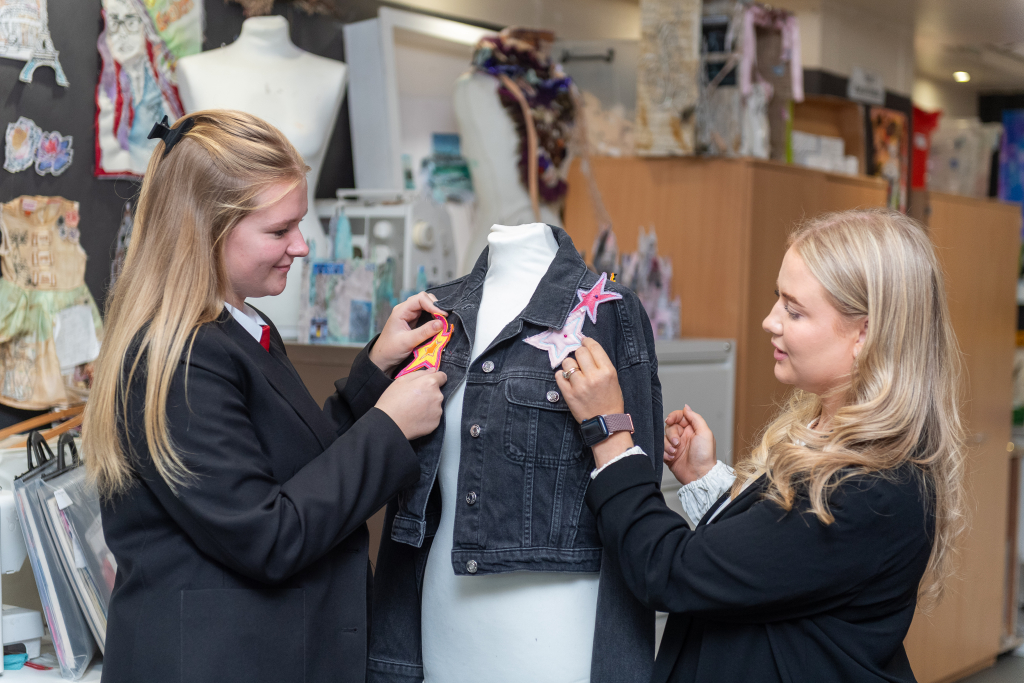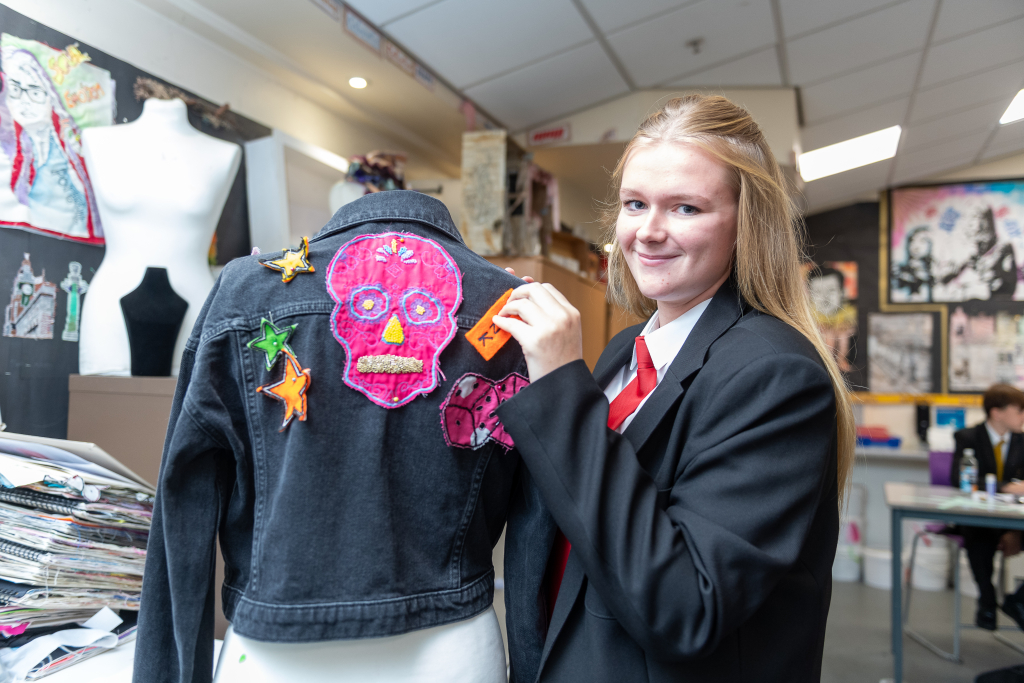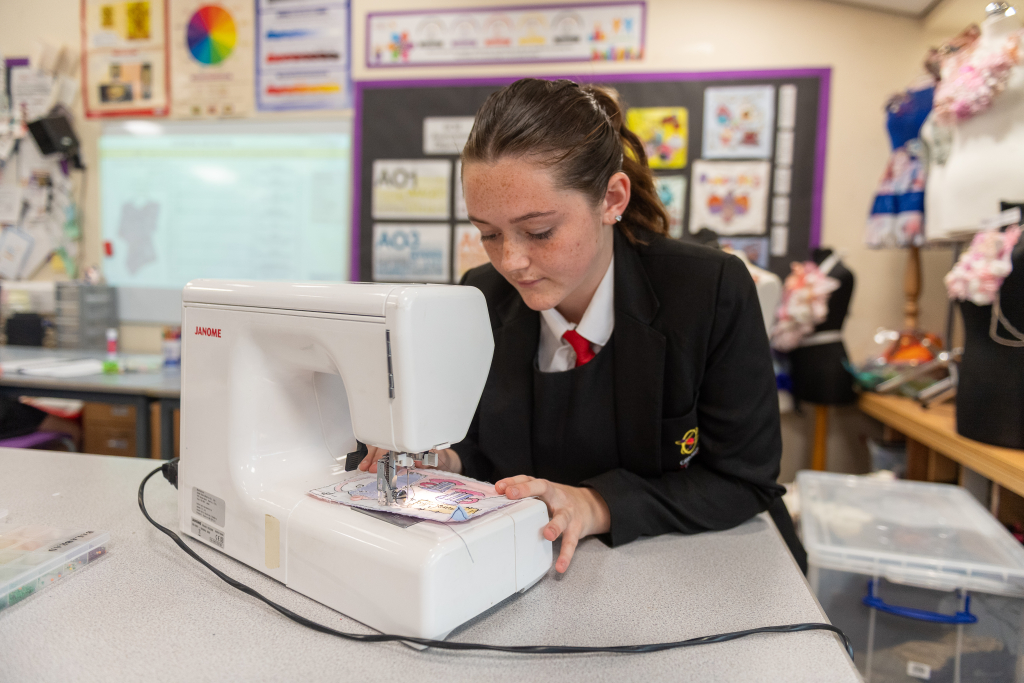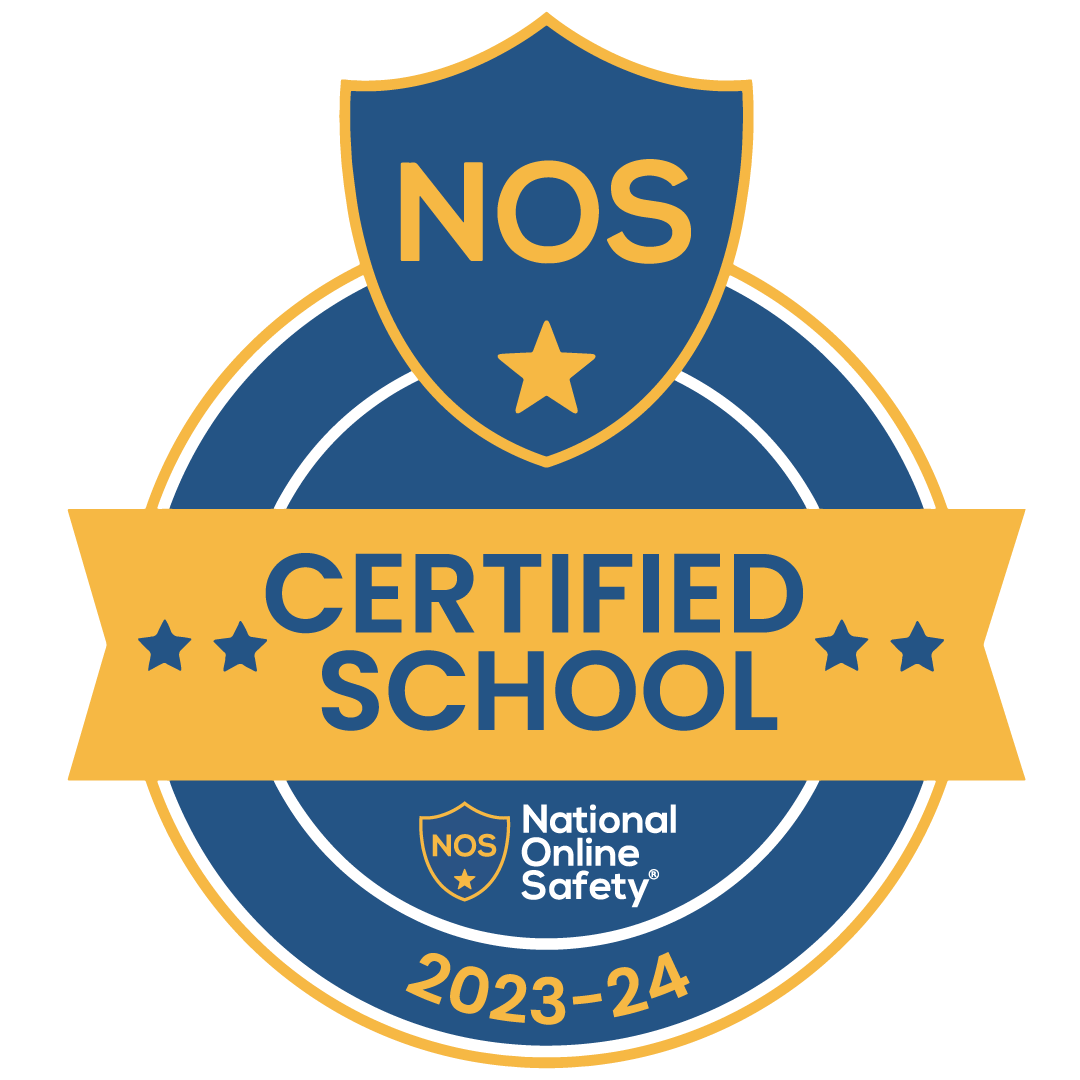Art and Textiles
Department Staffing & Roles
- Miss H Bridge – Head of Art and Textiles
- Miss C Baker – Teacher of Art and Textiles
- Miss Archer – Teacher of Art and Textiles (Maternity leave)
- Mrs C Coldwell – Teacher of Art / English
- Mrs H Parker – Teacher of Art / Technology
- Mrs H Shard – Teacher of Art / Technology
‘The aim of art is to represent not the outward appearance of things, but their inward significance.’
Aristotle
The Art and Design department has been the creative heart of the school for many years. It also has consistently achieved excellent exam grades and has gained a well-deserved reputation for the quality of its work. Art, craft and design embody some of the highest forms of human creativity. A high-quality art and design education should engage, inspire and challenge pupils, equipping them with the knowledge and skills to experiment, invent and create their own works of art, craft and design. As pupils progress, they should be able to think critically and develop a more rigorous understanding of art and design. They should also know how art and design both reflect and shape our history, and contribute to the culture, creativity and wealth of our nation.
| Ormiston Chadwick Academy Art Department Schemes of Work | |||
| TERM 1 | TERM 2 | TERM 3 | |
| Year 7 | |||
| Basic skills / Formal Elements / 3D shaded shapes | Jasper Johns Numbers | Cubist portraits Pablo Picasso | African masks |
| Year 8 | |||
| Year 8 shading pages personalied | Zentangle surface pattern insects | Jon Burgerman illustrations trainer design | Pop Art portraits |
| YEAR 9 | |||
| Term 1 Jon Burgerman trainer designs Term 2 Aaron Kraten illustration skateboards Term 3 Vladimir Gvodez steampunk animals | |||
| YEAR 10 | |||
| Fine Art – Architecture drawing skills, 3D buildings Textiles – Skills building with seaside / teatime theme with Textile artist workshop Priscilla Edwards | Fine Art – Modern Icons paintings Textiles – Garments, Vivienne Westwood, Alexander McQueen | ||
| YEAR 11 | |||
| Coursework Sept – Nov | Existing Coursework Improvements Dec | Externally Set Task (40%) Title chosen from exam paper Jan – May |
Key Stage 3 National Curriculum for Art and Design link
Secondary National Curriculum – Art and Design
Key Stage 4 Exam board link: (Fine Art)
Key Stage 4 Exam board link: (Textiles)
Year 7
The Year 7 course is designed to unify the varied art experiences gained at primary schools. Pupils explore the work of abstract expressionist painter Jasper Johns which builds up their basic art skills and knowledge. The main objective of Year 7 is to mprove pupils’ ability to work with basic skills and improve their painting and drawing confidence and ability. During Year 7 pupils research Johns’ work for home learning and produce designs and outcomes based on this style.
All pupils will have produced a range of research drawing and shading techniques in their sketchbooks. Font, text and image will be a main feature to create a basis for exploring these basic techniques. Most pupils will produce an A3 size outcome based on their knowledge from sketchbook work.
Year 8
The course content for Year 8 reinforces and then extends the foundation of knowledge, experience, understanding and skills laid down in Year 7 which then informs their chose. During Year 8 pupils develop their use of colour, showing use of colour blending and tonal colour. Projects included are ‘Bugs and Insects’, producing insect drawings, which clearly show the finer detail and the patterns of the insect. As students are introduced to their option choices, the department delivers a wide range of skills and research based projects so it gives students an informed and appropriate basis for the right choice for them. Schemes of work are tailored to suit the students’ interests and needs and expectations for students are high, therefore the outcomes reflect the expectations.
Year 9 Art
During Year 9 pupils will have undertaken artist research tasks and analysis of contemporary artists and illustrators such as Aaron Kraten and develop into their own versions inspired by his painting techniques. Pupils have developed drawings with an element of their own interests or influences through individual research. They will have the opportunity to experiment with collage using paint, paper, news print, layering etc.
Year 10 and 11 Art
In Year 10 students embark on their GCSE studies and therefore follow a varied programme of study designed to provide every student with a final opportunity to demonstrate their skills, knowledge and understanding to their full potential with regard to satisfying the exam board’s requirements (AQA). The Fine Art GCSE course is a popular option choice and the department is justifiably proud of the results achieved by the students. Year 10 and 11 students follow AQA’s endorsed Fine Art GCSE course. It is a two year course and the endorsement course involves students working in two or more of the following areas:
- Painting
- Mixed Media
- Sculpture
- Printmaking
- Photography
The Fine Art course is based on a selection of coursework (60%) and final exam (40%). Fine Art students develop their drawing, research pages into canvases, large scale pieces and through the use of ICT. They have developed their research and drawings of the designs to the best standard possible. As with the coursework, presentation, explanation and thoroughness are all very important.
Year 10 and 11 Textiles
The Art Textile course is based on a selection of coursework (60%) and final exam (40%). Textile students develop their design ideas, producing a minimum of three designs per project. They shouldn show clear links to their research. They make one of the designs to the best standard possible. As with the coursework, presentation, explanation and thoroughness are all very important.
Art instagram page: https://www.instagram.com/oca_art/
Marking, feedback and homework Policy for Art
Purpose and Aim
Marking and Feedback – Within the faculty we aim to provide all students with timely, high quality feedback on the work they are producing in lesson and at home. Our marking should provide information regarding how well students performed during a particular piece of work, their progress to date and feedback on their effort and AtL. Students should then respond in a positive manner to this by improving their work to ensure they make further progress. This process should ensure all students make progress and address misconceptions in their learning.
Procedures
KS3 – At KS3 in art, SoW for each project varies in the time scale delivered. Students will complete a mini knowledge test every 8 weeks. Teachers will deep mark students’ work using the marking sheet every 8 weeks. These two forms of assessments will alternate so students will receive an assessment
(marking or test) every 4 lessons. This marking and feedback can be presented in a number of ways. There is a faculty marking sheet which staff can use if they wish. Marking must be clear and in line with the whole school policy. Student response will take the form of the students acting upon the targets set.
KS4 – At KS4 SoW can vary in length. We will deep mark every 8 lessons and light mark every 8 lessons. These two forms of assessments will alternate so students will receive an assessment (marking or test) every 4 lessons. The deep mark will take place as a lesson ensuring the students understand the full mark scheme and how to achieve their target grade or higher. Following this deep mark during the lesson, students will respond to targets set to improve their work. The teacher will then check these improvements and where appropriate, re grade work 2 weeks later. There will be a second lighter mark every 8 lessons. This will use the mark scheme and targets indicating to students where they are presently at and how to improve. This marking and feedback can be presented in a number of ways. There are two department marking sheet which staff can use if they wish. Marking must be clear and in line with the whole school policy. Student response must take place. There will be no green pen but evidence will show students acting upon the advice set by the teacher.
Quality assurance process
Each half term, a book trawl will take place. The HoD will collect at random a selection of books from each teacher. These books will then be scrutinised using the whole school book trawl policy. Photographic evidence will be collected during the review. Each member of the team will then receive a photo sheet detailing what was seen in books. A judgement on the quality of marking and feedback will be given along with targets and areas for improvement. If the judgement made shows that marking and feedback is satisfactory or less, a further book trawl will be repeated within 3 weeks to ensure improvements are made. A judgement will then be reached about the quality of marking and feedback across the faculty and reported in the DSEF. The HoD will delegate, on occasion, book trawls to other members of the faculty as and when appropriate.

Key Stage 3 Art
Throughout KS3 students:
- produce creative work, exploring their ideas and recording their experiences
- become proficient in drawing, painting, sculpture and other art, craft and design
- techniques
- evaluate and analyse creative works using the language of art, craft and design
- know about great artists, craft makers and designers, and understand the historical and cultural development of their art forms.
- Year 7: 1 lesson per week of Art taught in mixed ability groups. Students explore
- Year 8: 1 lesson per week of Art taught in mixed ability groups
- Year 9: 1 lessons per week of Art taught in mixed ability groups
Key Stage 4
Fine Art
Students work will be assessed through two Components.
In Component 1 (Coursework 60%) students will research and investigate sources of ideas in Art, Craft & Design. They will explore and use Art, Craft & Design material and techniques to develop visual language. Students will complete a portfolio or sketchbook demonstrating their creative journey. This should be evidence of the process of developing both ideas and work. It should demonstrate research, supporting studies and work, showing the development of their ideas, leading to finished pieces.
Architecture – Students will research and investigate artists that have worked with architecture as a starting point. Students will then gather their own photography before experimenting with materials to create a variety of 2 and 3D outcomes
Modern Icons – Students will select their own icon working from artist research to inspire their outcomes. A variety of techniques through PhotoShop, painting and drawing skills are needed to complete a variety of scales from A1 to A0.
In Component 2 (Exam 40%), the exam board provides students with a theme for their exam. Students are given a number of weeks to develop ideas and prepare. Students sit a 10-hour exam in Year 11 in which they produce their final outcome.
Textiles
In Component 1 (Coursework 60%) students will research and investigate sources of ideas in Art, Craft & Design. They will explore and use Art, Craft & Design material and techniques to develop visual language. Students will complete a portfolio or sketchbook demonstrating their creative journey. This should be evidence of the process of developing both ideas and work. It should demonstrate research, supporting studies and work, showing the development of their ideas, leading to finished pieces.
Nature – Students will research and investigate artists and designers that have worked with nature as a starting point. Students will then gather their own photography before experimenting with materials such as batik, advanced sewing machine skills, tie dye, patchwork, free machine stitching, 3D flowers.
Garment design – Students will research designers such as Vivienne Westwood and Matthew Williamson. Students will then design their garment which will be an adapted recycled item in which they add decorative samples onto.
Year 10: 2 lessons per week of AQA GCSE Fine Art/AQA Graphic Communication / AQA 3D Art / AQA Textile design taught in mixed ability groups (option subject)
- 2 coursework projects completed in Year 10
- (60% coursework/40% externally set task)
Year 11: 2 lessons per week of AQA GCSE Fine Art/AQA Graphic Communication / AQA 3D Art / AQA Textile design taught in mixed ability groups (option subject)
- Coursework project (towards 60% coursework) Sept – Dec
- Externally Set Task (40% of final grade) from Jan – Apr
- (60% coursework/40% externally set task)
At OCA, we strongly believe that careers education is a vital aspect of our curriculum. In Art, we aim to broaden our pupils’ idea of the opportunities available to them post-16. In order to do this, we:
- Ensure the Gatsby benchmark is implemented across all year groups and all students have access to high quality careers opportunities, advice and guidance. The Gatsby Benchmark will be embedded into the curriculum throughout all year groups.
- Trips and gallery visits to appropriate sources that relate to the Schemes of Learning such as the Tate gallery, Liverpool World Museum that will also be cross curricular
- Career checkpoints in lessons such as Year 8 Insects project suggestion of Entomologist, year 9 Graphic designers, illustrators, fashion designers, gallery curators.
- Organise visits to both the University of Liverpool/University of Manchester to experience degree shows
- Arrange visits from artists and illustrators, fashion designers to do workshops
- Offer careers advice for pupils during the options process to guide/support in decision making
- Maintain our MFL careers board giving a wide range of career opportunities and the qualifications required

Art provides enrichment activities at art and textiles clubs, intervention sessions are tailored for all age and year groups. We also provide the opportunity to attend a residential for key stage 4 students.
Enrichment/Extra Curricular
The Art department regularly runs an after school art club on Tuesdays until 4.00pm. This is attended by Key Stage 3 and 4 pupils, whatever their ability. This year, the Year 7 Art Club designed the school Christmas card during the Art Club, whilst the Year 11 pupils began work on their Externally Set (exam) papers.
Educational visits include The Clothes Show Live at the Birmingham NEC for Textile pupils, the Manchester Art Gallery, the Manchester University Degree Show and art experiences at local colleges such as the Priestley College in Warrington. There are also additional trips to London to see the national galleries and residential courses at the Conway Centre.
Local primary school enjoyed an Arts Festival where pupils came to school to experience a jam-packed day of making cupcakes from materials and threads in Art, Drama produced a caption of the popular film, Charlie and the Chocolate factory and Music provided stunning performances of musical talent.
The art department provides opportunities for pupils to experience workshops with artists and practitioners such as a Graffiti artist working with Year 8 and a local artist working with Year 10.

It is very important to experience an art gallery or museum, here are a few virtual gallery links, the perfect way to explore gallery and get up close to paintings without the crowds!
- Tate gallery online www.tate.org.uk/kids
- British Museum https://britishmuseum.withgoogle.com/
- Salvador Dali gallery https://thedali.org/virtual-tour/index.html
- The Louvre Paris https://www.louvre.fr/en/visites-en-ligne
- The National Gallery https://www.nationalgallery.org.uk/
Key Stage 4
BBC Art bitesize https://www.bbc.co.uk/
Further Education Opportunities
Locally, we have excellent post-16 provisions for language study at A-Level and beyond. There are several options for language study and we love to see our pupils continuing with this life skill. Below are some links for further study options:
- Cronton College – A-Level Fine Art
- Cronton College – A-Level Textiles
- Cronton College – Foundation Art and design level ¾
- Cronton College – Art and Design – Level 3 UAL Extended Diploma
- Cronton College – Fashion – Level 3 UAL Extended Diploma
- Cronton College – Art and Design – Level 2 UAL Diploma
- Carmel College – A-Level Fine Art
- Carmel College – A-Level Textiles
Culture Capital
At OCA, we believe that opportunities outside the classroom are just as important as those that we find in lessons. Art study lends itself perfectly to developing a broader sense of self and we aim to offer as many opportunities as possible for our pupils to link creative arts learning to real life.
Trips include:
- Liverpool World Museum
- Manchester Metropolitan University – Art and fashion degree shows
- Tate gallery Liverpool
- Art residential Conway Centre, Wales


